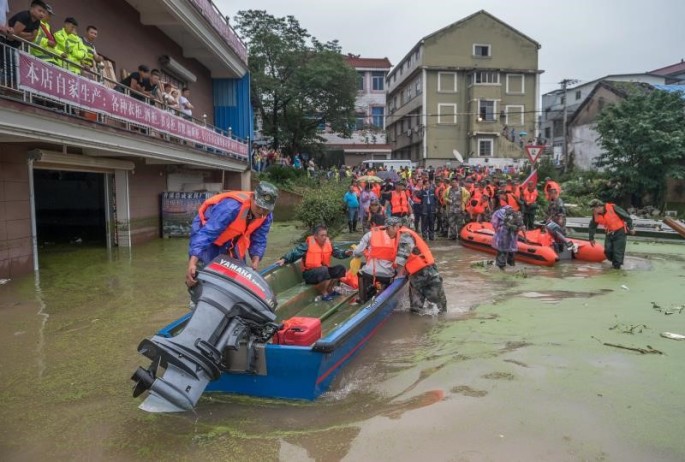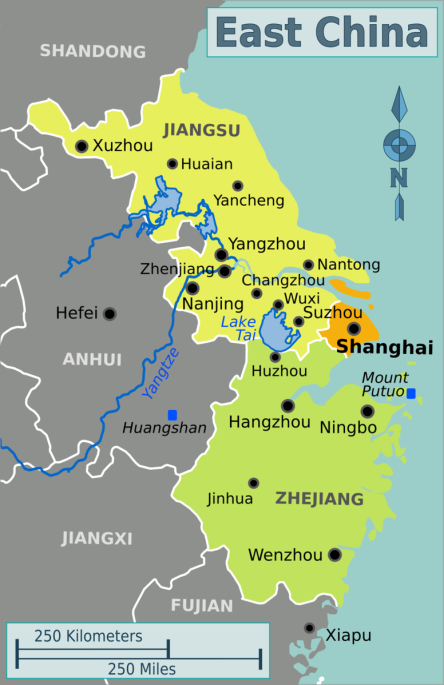-
Ten Years, Nine Floods: Local-Level Climate Adaptation in China
March 29, 2018 By Julia Teebken
The Lanjiang river in Eastern Zhejiang, China, reached its peak water level of 100 feet the night of June 25, 2017. Lanxi residents remember this day as “6.25,” marking the worst flood since 1955. Elsewhere in China that month, 7.3 million people were affected by floods, landslides, and heavy rains in northwestern Sichuan Province alone. Northern Guangxi suffered direct economic losses of 2.9 billion RMB (US$460 million). In the autonomous regions, 92,000 people were relocated. Flash floods caused the deaths of 10 people and forced 76,800 people to evacuate from Shanxi Province.
The World Economic Forum’s most recent Global Risk Report, published in January 2018, identifies extreme weather events as the most likely and impactful risk facing the world today. China is in the top 10 percent of countries at the highest risk of major natural disasters, as well as in the top 1 percent of countries affected by drought and its impacts on agriculture. As the frequency and impact of extreme weather events and natural disasters—such as torrential rain, droughts, typhoons and heat waves—continues to increase due to global climate change, they will continue to have large impacts on small local communities like Lanxi. These problems can only be addressed through proactive measures, rather than reactive efforts.
“In the Flood, We Are Together”
In the midst of the Chinese New Year celebrations, the local government of Lanxi held a conference to draw up a “Battle Map” for the city’s safety and environmental protection efforts. A few months earlier, at the “Extraordinary Flood Summary Conference,” local officials embraced the “spirit of flood fighting” and emphasized the swift reaction of the government, army, and civilians, who all joined the “flood-fighting frontline.”
Floods, weather changes, and other environment-related events have always been considered “natural disasters.” However, like other recent extreme weather events, the 6.25 flood in Lanxi is different—it is not just a randomly occurring disaster, but a part of a pattern of increased flooding over the past few decades.
Lanxi has experienced more than one hundred floods since the founding of the People’s Republic of China in 1949, 41 of which reached critical water levels. The majority of these critical events took place in the past three decades. On June 20, 2011, the flood water levels reached 104 feet, collapsing 158 homes and affecting 16 townships, 325,000 people, and 13,800 acres of land. Direct economic losses reached 1.1 trillion RMB US($171 million). Until this past year, “6.20” was the worst flood since 1955. Although climate change is a complex phenomenon, the flooding in Lanxi is in line with local and national assessments predicting that climate change will lead to an increase in the frequency and intensity of extreme precipitation and storms.
Despite Momentum, Climate Change Adaptation Gaps Persist at the Local Level
China’s National Development and Reform Commission has initiated some measures addressing adaptation planning at different levels of government. The 2013 National Adaptation Strategy, China’s first national adaptation plan, identified 14 pilot provinces and mandated the development of provincial adaptation plans. In 2016, the Urban Climate Adaptation Action Plan designated 28 pilot cities and further integrating climate adaptation into municipal governments’ urban development planning.

So far, Lanxi is not part of any of these pilots. However, some measures against flooding undertaken by the provincial government as part of the Sponge City Framework are proving to be an accidental form of adaptation.
Initiated in 2011, Yanweizhou Park (located in in Jinhua prefecture, of which Lanxi is a part) was among the first of the central government’s projects related to green infrastructure. The park is a resilient urban landscape that integrates flood-adaptive native vegetation and natural habitats in an effort to create a harmonious balance between nature and society.
Although Yanweizhou Park is part of the city’s flood and emergency management, like most climate adaptation projects, it was not planned as one. Compared to mitigation, climate adaptation’s benefits are largely invisible and require long-term planning horizons. In addition, climate adaptation involves different levels of governments, ministerial branches, and non-state actors—adding to the challenge.

A More Proactive Approach to Climate Disasters
Even though 79,200 people were affected by the flood in Lanxi in 2017, and although it received considerable attention from the district- and prefectural-level governments, it did not make international news. These fleeting moments of increased local awareness do not translate into proactive efforts to address and prepare people for climate change-related extreme weather events. Rather, ad-hoc measures continue to be the most common way of dealing with disasters not only in Lanxi, but globally.
These ad-hoc policy efforts separate natural disasters from the larger phenomenon of climate change. In this reactive pattern, the politics of attention often works against rural or impoverished populations. Human vulnerability and community exposure to climate change are sidelined by other policy demands, and adaptation is addressed only incrementally.
To integrate climate adaptation into existing disaster risk reduction frameworks, we need to connect government departments and non-state actors in different sectors. And to prepare communities like Lanxi for the future, we need to increase local-level awareness of institutional and human vulnerability to climate change—not only in China, but around the world.
Julia Teebken is about to finalize her PhD research at the Graduate School of East Asian Studies and the Environmental Policy Institute at the Political and Social Sciences Department at Freie Universität Berlin. She is currently a visiting scholar at the Kennedy Institute of Ethics (KIE) at Georgetown University in Washington DC (April-August 2018).
Sources: Bai 2013, China Daily, IPCC 2012, Jinhua News Network, Lanxi News, National Development and Reform Commission, Relief Web, Shi and Kasperson 2015, Sina
Photo Credits:
Soldiers boat rescue residents affected by the “6.25 flood” in Lanxi, Jinhua Prefecture, Zhejiang Province, courtesy of Huang Zezhen.
Map of Eastern China with Zhejiang Province, courtesy of wikimedia.
Ecosystem-based flood adaptive landscape, Yanweizhou Park, Jinhua Prefecture, Zhejiang Province, courtesy of Julia Teebken.
 A Publication of the Stimson Center.
A Publication of the Stimson Center.





